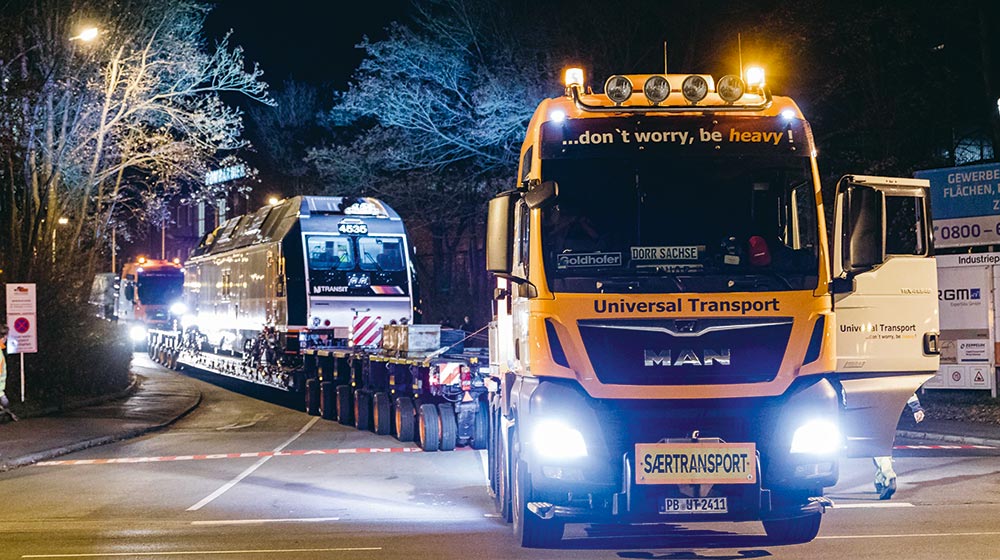
Jan Peter Naumann
Karsten Reichel carefully steers the heavy-goods convoy through a traffic circle on the outskirts of Lichtenau (near Paderborn, Germany). The trailer is carrying one of 25 locomotives that will be used in scheduled services in the New Jersey/New York metropolitan area. The team at Universal Transport Group and its subsidiaries are handling its transportation between the factory in Kassel and the customer in the United States. Karsten Reichel has been working for the Paderborn-based logistics group since 2010, so he has many years of experience in driving particularly large, long, or heavy loads. But this job is still quite special.
It has taken more than a year to plan and prepare for transporting the locomotive. A special center lane had to be asphalted on the aforementioned traffic circle, and a new vessel bed trailer had to be designed and built for this journey.
Loading at the Kassel factory
For the locomotives, the journey starts at the factory in Kassel. This city in Germany’s northern Hesse region is well-known for hosting the “documenta” art exhibition, but it also has a long history in the manufacture of rail vehicles. For this particular order, 25 ALP-45DP DualPower locomotives were ordered from Alstom, formerly Bombardier, for the U.S. company New Jersey Transit.
But a long journey lies ahead. The locomotives produced at this plant are normally transported by rail. But that’s not possible in this case because they aren’t suitable for use on the German rail network. At 32 metric tons, the axle load far exceeds the maximum 22.5 metric tons that is permitted in Germany. In addition, the wheel profiles do not fit the rails in Europe.

Every inch counts
First of all, the 90-metric ton body – still without bogies – is transported to the port in Hamburg. Karsten Reichel is up front behind the wheel of the truck. But its 640 PS-engine is not powerful enough to handle gradients, so a second MAN TGX is at the back to push or brake the vessel bed trailer as required. Karsten Reichel and his colleague Hendrik Neubauer are in constant radio contact, coordinating every driving maneuver with absolute precision so that the transport progresses without a hitch.
The special trailer placed between them has 14 axle lines and 112 tires. With a maximum width of 52 feet, it can carry up to 160 metric tons of cargo. There are only a handful of similar vessel bed trailers in the world, but most of them carry much lower payloads. Its special low-slung design makes it possible to transport vehicles with a height of up to 144 feet. This was particularly important for transporting the U.S.-bound locomotives – with a conventional trailer the journey would have been over within a few miles when it reached a particularly low bridge near Vellmar.
All the same, absolute precision and a sure instinct are vital for negotiating every bridge on the route. The low-loader is hydraulically lowered almost to road level. With clearances of just two inches above and no more than one inch below, it creeps through at a snail’s pace. This is not the only tricky section on the route as it wends its way beneath bridges and through small towns. This is the only possible route because Germany’s highway network and bridges are somewhat dilapidated, making them unsuitable for this type of load. Travelling on freeways and main roads, it takes four nights for the team to cover the 223 miles to the port in Hamburg.
A floating crane takes the strain
Once it reaches Hamburg itself, the locomotive has to take a detour. This is because, with its total weight of 230 metric tons, the heavy-goods convoy is unable to cross a bridge to the terminal. Karsten Reichel has to take the locomotive to another terminal. A floating crane lifts it off the truck and transports it some 4 miles on the Elbe to the actual departure terminal.
Here, the bogies are fitted to the body of the locomotive. Carefully secured on a Mafi roll and cargo trailer, the locomotive, now weighing 130 metric tons, is loaded onto a ro-ro ship that carries it 3,700 miles across the Atlantic to New Jersey, where it is unloaded onto the American rail operator’s tracks.
Two locomotives have already reached their destination in this way, and 23 more are set to follow by 2022. The international logistics company Züst & Bachmeier is responsible for organizing and handling their transportation, including unloading at the US port. The route itself is prepared by StB Verkehrstechnik, which also provides four vehicles to escort the convoy. The transport service is provided by the freight forwarding department at Universal Transport.
Do you have a special request?
Contact us if you would like to learn more about the efficiency of German logistics!